Dear Friends,
My wife Jean and I spent the Fall Equinox last month in the Sierra Nevada Mountains, where we were staying near Donner Lake at 6,000 feet altitude. The day of Equinox, I honored the sacred moment of balance between the dark and the light with one of my lifetime highs: a swim in fresh, cold mountain water.
Exhilarating! As I glided through the bracingly cold lake, looking up at the tree line, I quieted within myself, immersed in something larger than me—a great, unfathomable beauty. I emerged from the water after swimming for thirty minutes on the sunny afternoon with that tingling glow that remains for hours, feeling young and springy, as if I was once again 35 years old, as if I had entered a new life.
Sitting in the sun afterwards, warming up and glowing inside, I could not help but remember the times I have spent the Fall Equinox in another lifetime high: in Ireland on Slieve na Cailleach, the Mountain of the Old Woman, or Mountain of the Hag. This Irish mountain is closer to 900 feet altitude than the Sierras at 6,000, still Slieve na Cailleach is the highest point in County Meath in the Irish midlands.
The mountain’s modern name is Loughcrew, but alongside that, on any road sign anywhere in Ireland, you will find the ancient words: Sliab na Cailli—Sliab or Slieve meaning “mountain” and Cailli for Cailleach, an ancient old hag woman of Irish folktales. The Cailleach is a giantess who can fight or outrun any man, who is said to be older than time, the ancient goddess of the land, akin to the great forces creating the landscape itself.
The hills of Slieve na Cailleach are also famous as the venerable site of 32 Neolithic passage mounds, built by ancient peoples in Ireland 5,500 years ago. These magical structures of megalithic stones long ago took my soul. My love for them has in some ways shaped my life, and I have returned again and again, often bringing others with me. To be in the presence of these elemental stones is to feel stripped to one’s core, in the best sense, returned to oneself, to something very old within us, and without words.
These stones, too, hold something profound about human intentions regarding what is left on the landscape. For they were carefully set together by humans hands to form passage mounds with the entrance oriented to the sun on Equinoxes or Solstices. The engineering involved, so long ago, can boggle the modern mind. One such magical mound was built on Slieve na Cailleach, known as “Cairn T” (cairn referring to a heap of stones or an ancient mound), which was designed with the entrance oriented to receive the precise rays of the rising sun on the Fall and Spring Equinoxes.
The first time I climbed Slieve na Cailleach and visited Cairn T at Loughcrew, I was rearranged at some cellular level. It was July 2002, and I had brought a group of twelve writers on my very first Writing Retreat and Tour in Ireland. I’d never heard of Loughcrew; it had been suggested by our guide Gerard Clarke. As we followed him up the hill for a 20 to 30 minute gentle, steady climb, I had no idea what to expect.
Once we arrived at the top, we stood a little dazed in front of Cairn T. We were looking at a strange hill, about four or five times our height, with an opening formed by large massive stones, standing upright.
The entrance was about five feet high, and we hunched down and followed Gerard inside through a short passageway. When we reached the circular inner chamber, built entirely of megalithic stones, we found that it was large enough for all of us. It was like walking into a cave, but then, not quite. Some stones were carved with ancient symbols, and these carvings immediately grabbed the eye.
There were pinwheels, spirals, V’s, circles, dots, stars, chevrons, wiggly lines. We stood in puzzled silence. It was strange—and then strangely familiar. Being with the carved stones was both moving and disorienting; we were looking deeply, but we’d lost the inner script to understand the meaning. The most noticeable repeating symbol was a circle with rays, seemingly the universal symbol of the sun. We had entered a hallowed place, and were torn between the urge to study and photograph, and another to bow our heads and pray.
We stayed for some time, and as writers began to quietly leave to explore the sacred hill, I remained within. I sat on the earth in silence. The stones quietly glowed. A bit of sun flowed through the passageway, creating soft easy light. A quiet, pervading sense filled the air, like sitting in the solemn pews of a church, a place which called forth the eternal. I bowed my head in wonder and gratitude.
When I finally emerged, I looked around, astonished. I simply had not remembered the spectacular view when we climbed up. The land glinted like a tantalizing blanket of beauty. The sun opened; it lit the endless patchwork of green fields. On that bright afternoon, the mottled green land, hills, meadows and fields went on and on; there was no edge and no sea, just Ireland, Ireland itself.
In the local tale, it is said that eons ago the Cailleach would become mistress of all this gorgeous land of Ireland—if she filled her apron with stones and jumped from each of three hills of this ridge. The ancient giantess jumped from one hill and dropped a handful of stones, which became a large cairn of many tons. She leapt to the next hill and dropped another handful of stones, which accumulated into yet another massive cairn. She jumped to a third hill, a full mile away, dropped yet more stones, and finally fell and broke her neck. She was buried nearby, thus merging with the land, giving this place its name—and remaining forevermore.
At the edge of Cairn T is the “Hag’s Chair,” a massive stone carved into a wide seat, a bit like a throne. It is said that the Cailleach sits on that stone to smoke her pipe, and that sometimes she might be seen at night riding her pony. The locals say that a wish made while sitting on the Hag’s Chair will always come true. Thousands of visitors year after year sit on the stone, making wishes not to the sky or upon a twinkly star, but to the great old woman of the earth. I have sat there myself making a prayer or a wish to the Cailleach many times. As have several of the writers and artists who have traveled with me there.
Since that first visit in 2002 I have climbed Slieve na Cailleach every few years. Each time I am in awe of the ancient wisdom of the stones, and astonished all over again by the spectacular view. Indelibly imprinted on my soul is an awe-inspiring Equinox morning in 2016 when we witnessed the rising sun flow directly into the inner chamber of Cairn T, illuminating the sunwheels on the decorated stone. Probably 200 people were there with us that morning; we all waited in line patiently and gratefully to enter the mound. For we all knew well that we were lucky: you can get to Ireland, you can climb the sacred hill in the pre-dawn darkness on Equinox morning, but that doesn’t mean the rainy Irish sky will be clear and the bright rays of the rising sun will actually reach Cairn T. The great joy of that experience became even more clear in 2019 when the mound interior was closed to visitors for the time being, in order to care for and protect it.
Still, what I remember most are the days I have visited Slieve na Cailleach alone or with a group of writers on an ordinary day, not on an Equinox, the hill quiet except for our small group. Days when we have been able to remain on the sacred hill with the stones and the Cailleach’s incomparable view in profound silence for an hour, or several.
The mossy remains of several smaller passage mounds dot the hill outside Cairn T —stones which it is said the Cailleach scattered from her apron as she leaped the Loughcrew hills. Each time I bring a group to Ireland we climb the mountain, and these mystical ruins are explored by my American writers and artists, each on their own inner journey. The stone roofs of the smaller mounds are long gone; there is no covering, no earthen hill. Just the set pattern dug into the earth—a passage of stones through which one can walk into the interior, open now to the sky, with its three smaller chambers outlined by stones.
On that first day in 2002, with our group alone on the sacred mountain, we lingered on the hill for some time. At one point I came upon Jean sitting inside one of these ancient open craggy mounds. I no longer have the photograph, but I remember it clearly. Time had stopped; the breeze was easy and warm. She was alone, deep in thought, unencumbered by life and things. It seemed that eternity filled her being. I came upon her unaware, and quickly stepped back. It was as if she’d stumbled back in time, was now ancient, sitting among the grey-green stones that suddenly matched the color of her eyes.
Since then I have seen that same look in many writers eyes. And I have bowed, stepped away, left them to themselves.
There are places on this Earth that open our souls and enter us forever. We all have such places, from distant and recent times in our lives. Some are across the world from us and some nearby in our neighborhood or town. They are sometimes called “thin places” by the Irish, since the barriers that separate us from ourselves and from the divine essence all around us are thinned when we are there. These places give us access to our own souls and the soul of the Earth. We go to them as often as we can, and when our physical bodies cannot make the trip, we go there often in our minds.
This year I was privileged to be in one of those sacred places on the Equinox, high in the Sierra Mountains, immersed and cleansed in the great womb of a natural mountain lake. As I emerged from the waters, like emerging from the mound on Slieve na Cailleach, I felt that I had entered into a new kind of light, and a new life.
Donner Lake has now joined the places that have opened my soul, such as Slieve na Cailleach and many others, and will be with me forever. I am sure you have your own such places. They save us, restore us, and in my case and perhaps yours, they help us know who we are. They give us our lives.
All photos by the author (with the exception of those otherwise attributed.)
You can find spectacular images & writing about the Equinox sunrise at Loughcrew (and many other amazing places) in Sacred Stone, Sacred Water: Women Writers and Artists Encounter Ireland, which emerged from my 2016 Ireland writing retreat & tour.
You can read about the Cailleach in many sources, notably the brilliant book by Gearóid Ó Crualaoich called The Book of the Cailleach: Stories of the Wise Woman Healer, 2003. Highly recommended.
The feminist mythologist Sharon Blackie has just published Hagitude: Reimagining the Second Half of Life, 2022. She writes about the Cailleach and many other ancient old women of folktale and myth. You can find her Substack here, and more at her website.

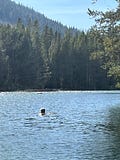


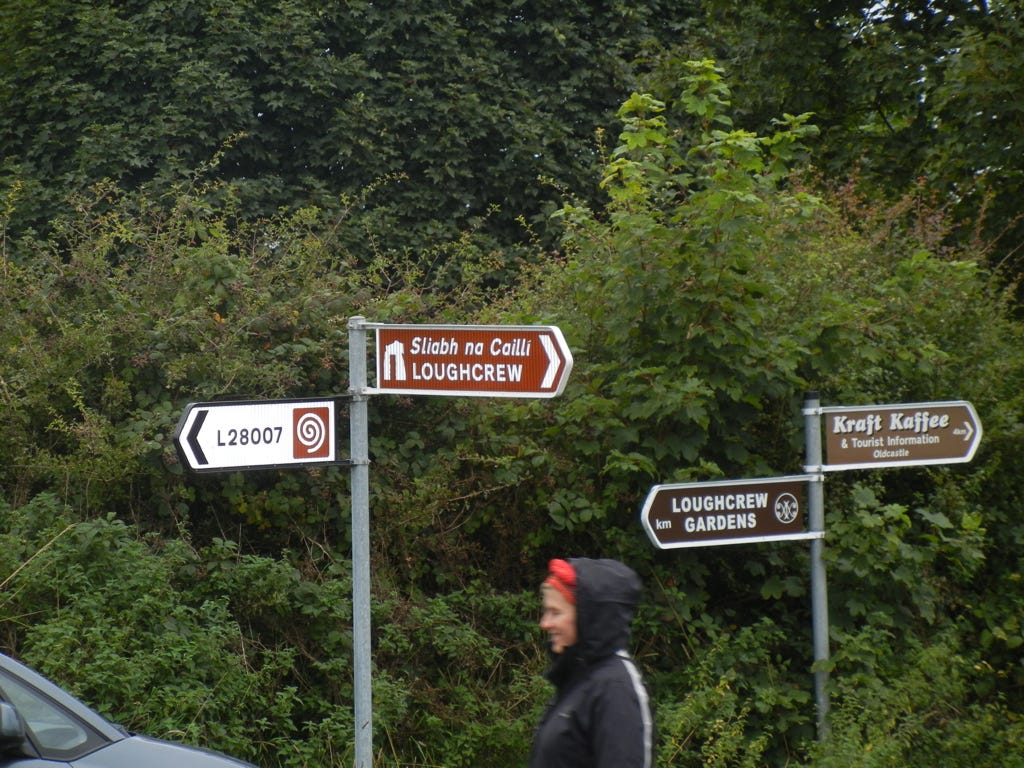



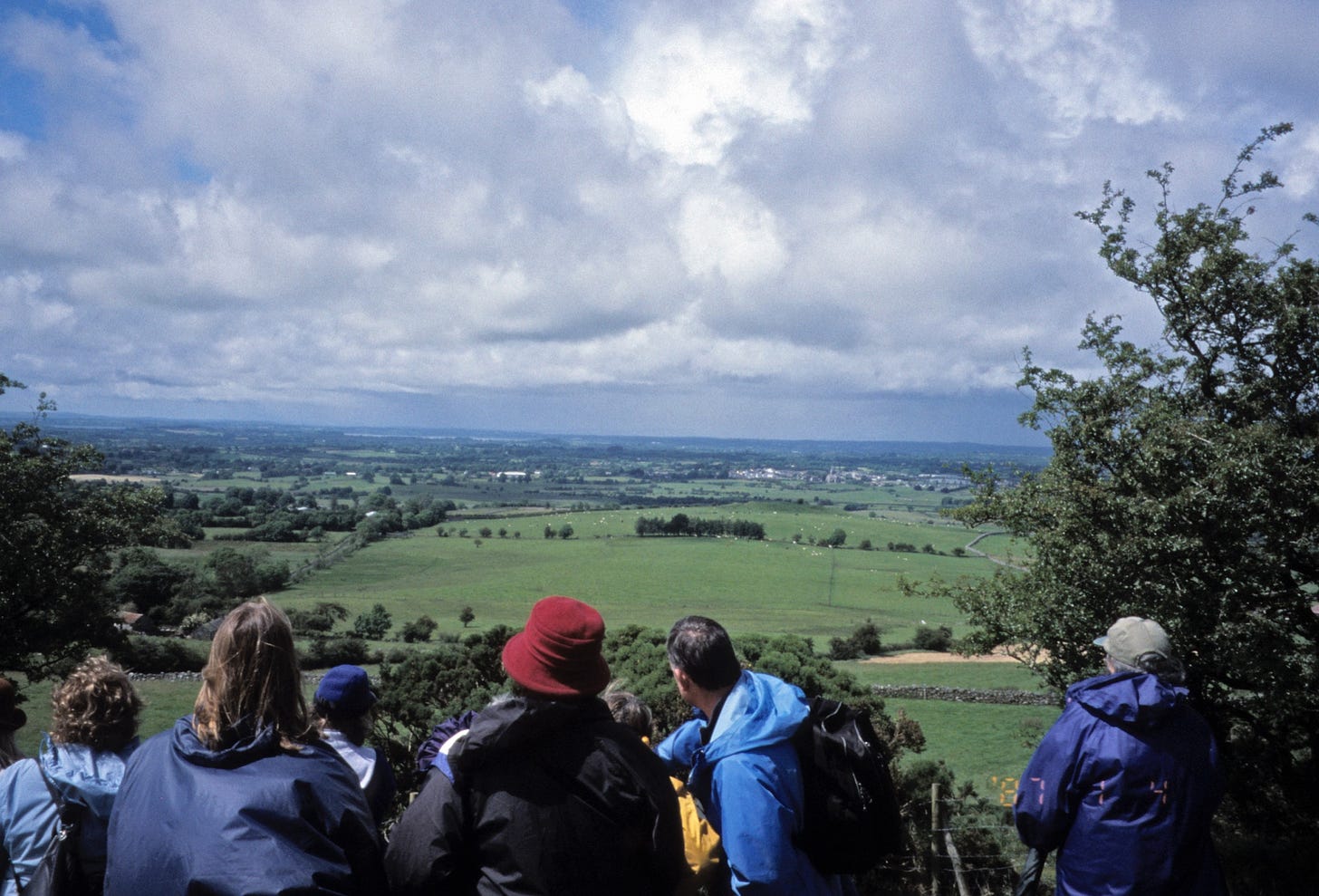

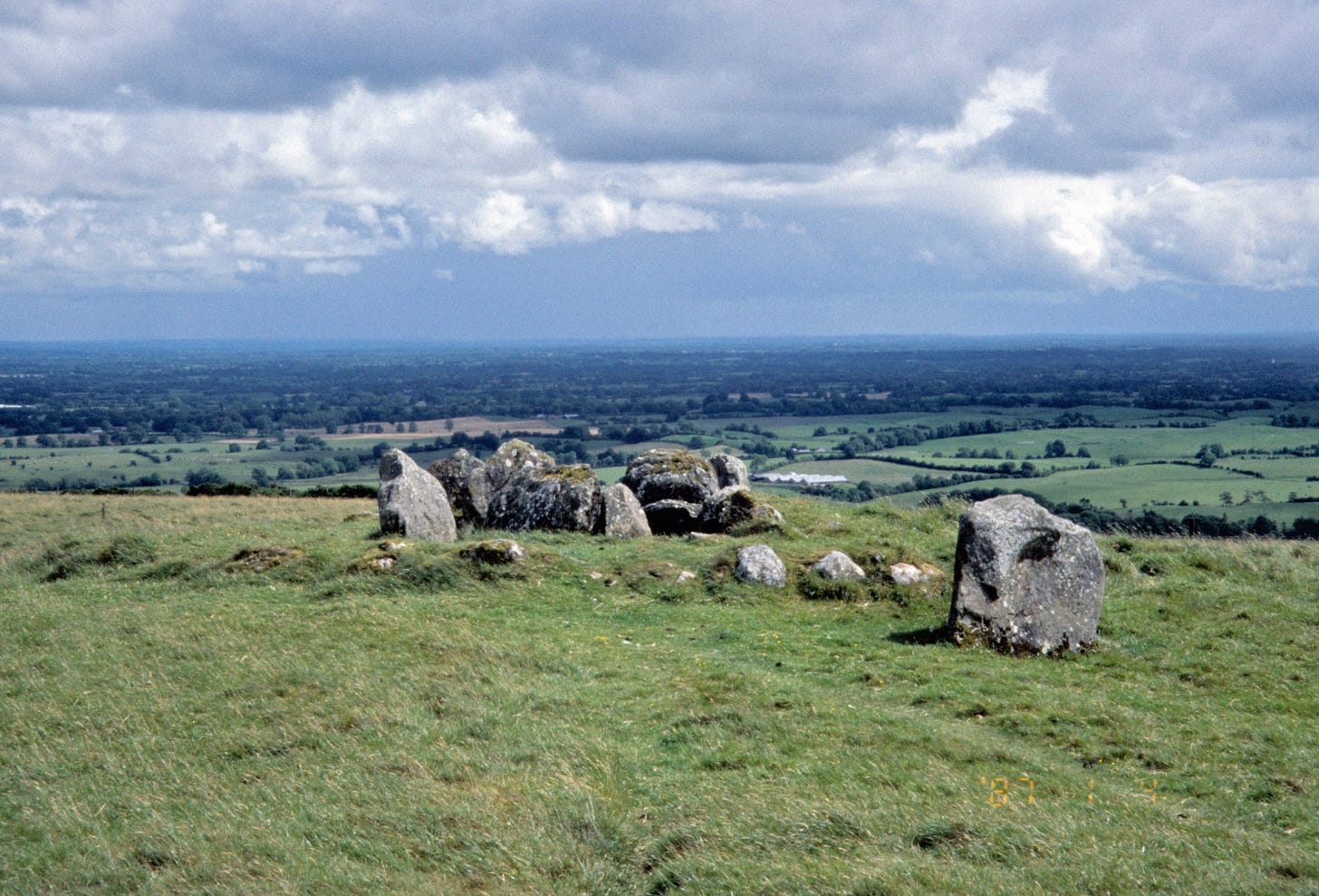
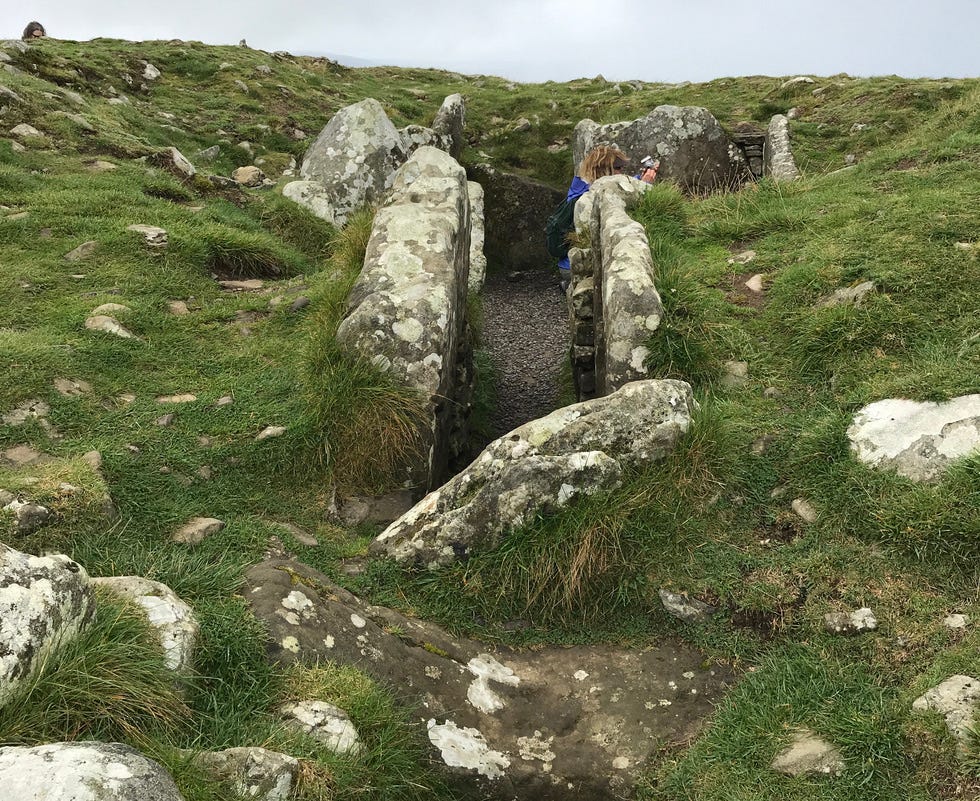





Got it. I didn't know I had other people's photos in my software. I'll happily update. Blessings, C.
Eva Brunner on the “Hag’s Chair,” Slieve na Cailleach, July 2007
Photo credit:Karen Koshgarian